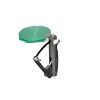mikemyers
Member
I'm visiting a relative who owns a Dillon 550. He has no experience at reloading, and my suggestion for a while was to get the RCBS Hand Priming tool, and use the Dillon as if it was essentially a single or two station press. Not very efficient, but he needs to learn reloading, and didn't like my idea of starting out with a single station press.
So, we bought the RCBS Hand Priming tool, which comes set up for large pistol primers. He shoots 38, so we had to convert it to use the small primers. I got stuck trying to figure out how to install the primer seat plug, but eventually it all made sense, and the tool is completed.
Here's my question. I had him drop 4 primers into the square "primer tray assembly", we slide that into the tool, I told him to allow a primer to fall through the gate into the tool, and it did so - but dropped in on its side.
We're using the small primer seat plug, and the small (white) primer feed.
I haven't yet tried this myself, but I assumed the clearances were such that this should be impossible. My only thought is that maybe he didn't push the primer tray far enough into the tool. Another possibility is that the shell needs to be in place before dropping the next primer through the gate, but we did this as per the written directions.
Anyway, as things stand now, I told him to check every primer before sliding in the next case. Is there anything else to check or adjust?
(I never saw one of these being used before, and I didn't expect to be impressed. Wrong. It's a very nice design, is easy to hold, easy to use, and very simple. The priming can be done on one's living room, while relaxing in a comfortable chair. Very nice!)
Same tool as we have, but this one has a round tray, not square, and sells for $10 less:

So, we bought the RCBS Hand Priming tool, which comes set up for large pistol primers. He shoots 38, so we had to convert it to use the small primers. I got stuck trying to figure out how to install the primer seat plug, but eventually it all made sense, and the tool is completed.
Here's my question. I had him drop 4 primers into the square "primer tray assembly", we slide that into the tool, I told him to allow a primer to fall through the gate into the tool, and it did so - but dropped in on its side.
We're using the small primer seat plug, and the small (white) primer feed.
I haven't yet tried this myself, but I assumed the clearances were such that this should be impossible. My only thought is that maybe he didn't push the primer tray far enough into the tool. Another possibility is that the shell needs to be in place before dropping the next primer through the gate, but we did this as per the written directions.
Anyway, as things stand now, I told him to check every primer before sliding in the next case. Is there anything else to check or adjust?
(I never saw one of these being used before, and I didn't expect to be impressed. Wrong. It's a very nice design, is easy to hold, easy to use, and very simple. The priming can be done on one's living room, while relaxing in a comfortable chair. Very nice!)
Same tool as we have, but this one has a round tray, not square, and sells for $10 less:


